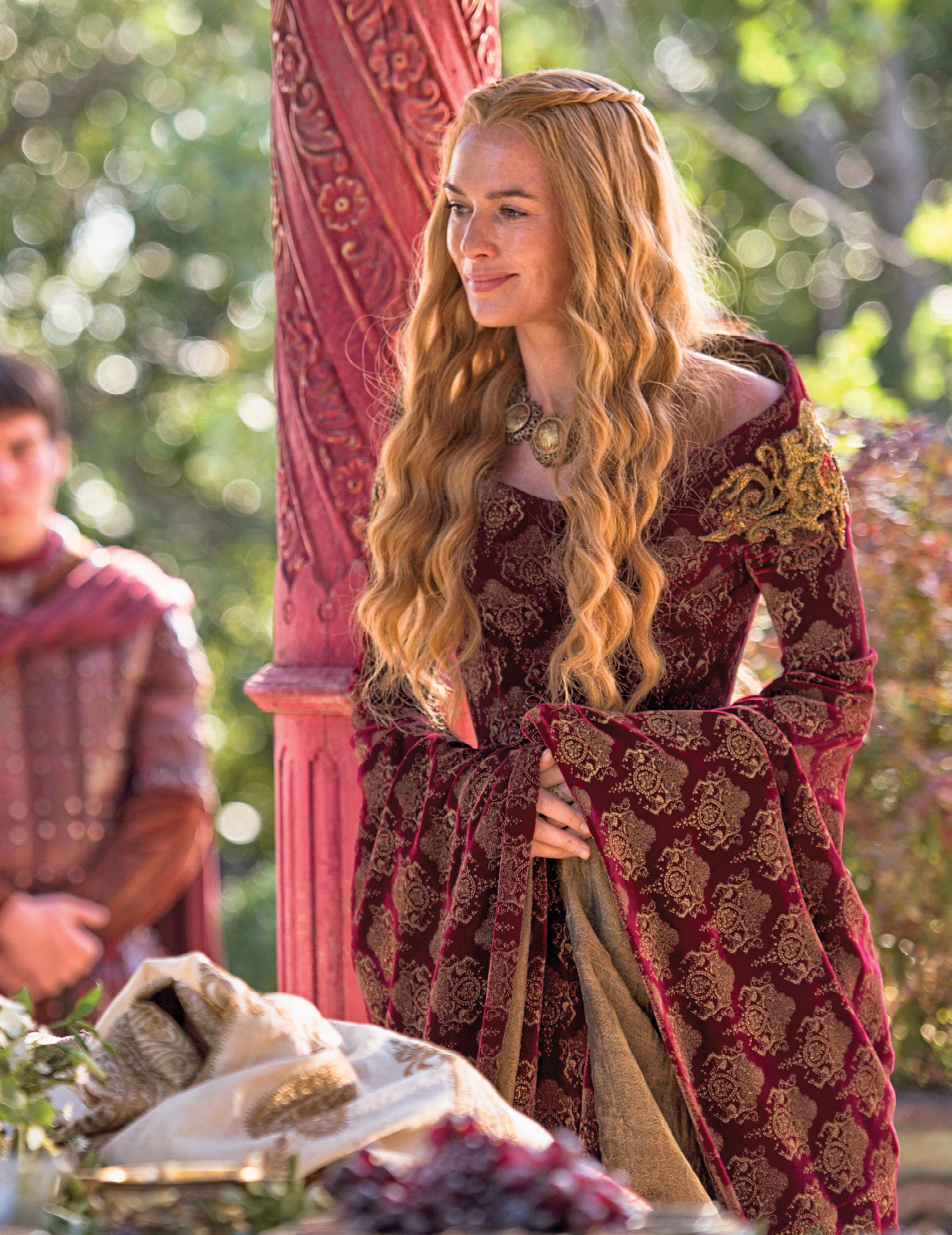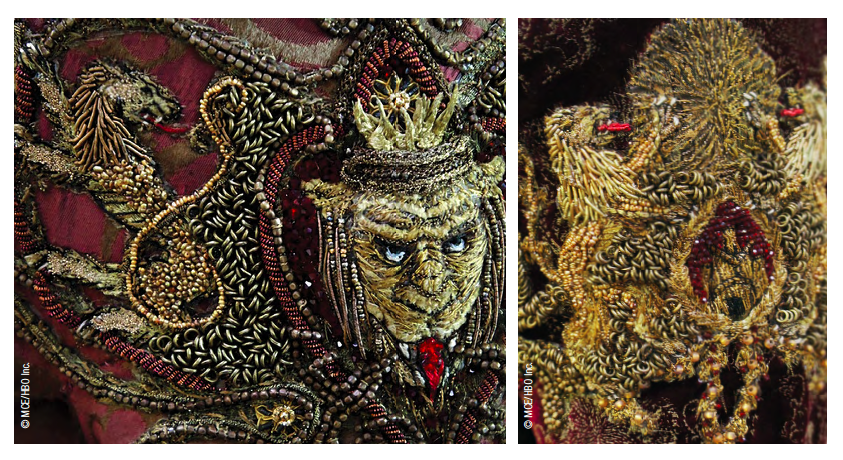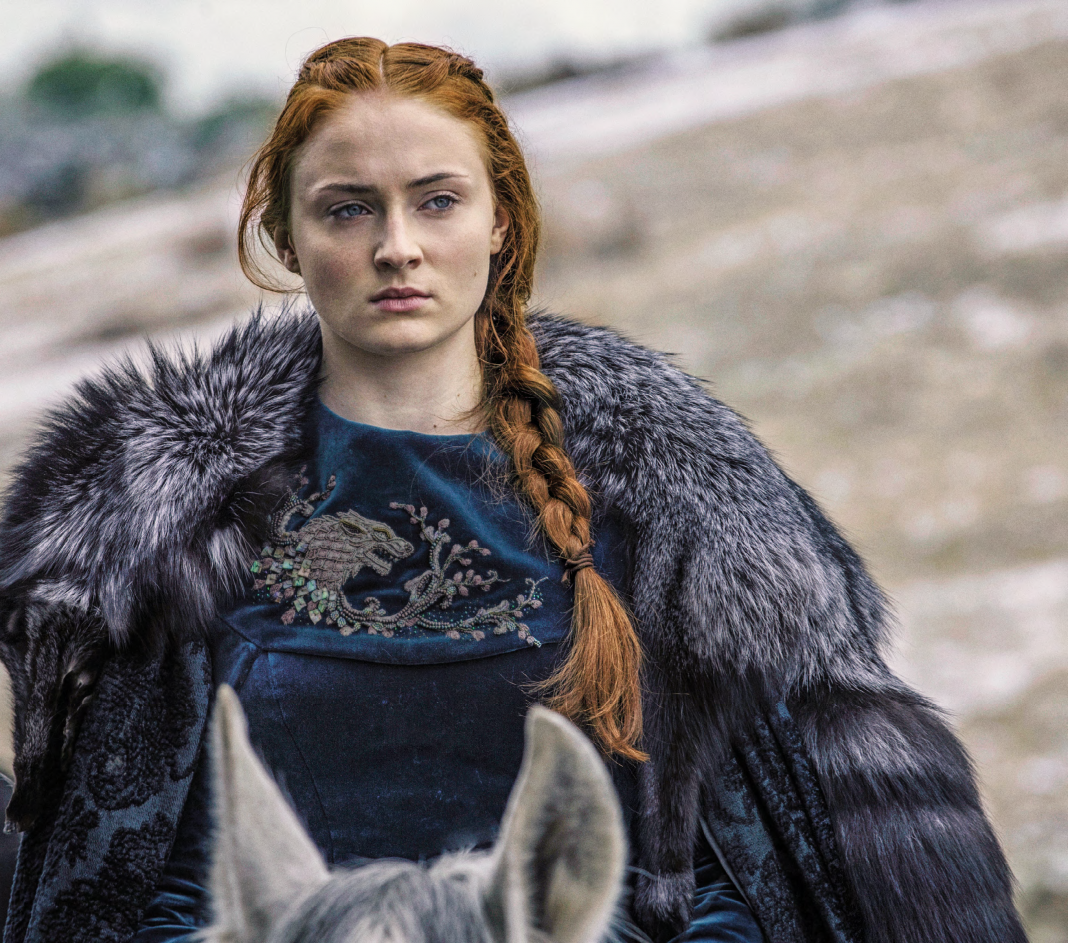When thinking of our favorite medieval-inspired fashions, we couldn’t help but turn our minds (and hearts) to our favorite show, Game of Thrones, and all our beloved (and beloved to be hated) Targaryens and Starks and Lannisters and their enviably lavish garb. If you look closely, many of the fashions on the show feature gorgeously glittering encrusted embroidery, too—a dire wolf snarling among curling flowers; multi-colored, three-dimensional flying birds; a roaring, crowned lion. These sly commentaries are the doing of costume embroiderer Michele Carragher, who’s worked under costume designer Michele Clapton since the show’s beginning, in 2011. We can’t imagine a more glamorous task. Here we ask Carragher about her background and work on the show.

Faerie Magazine: How did you become interested in historical costuming work?
Michele Carragher: I have specialized as a hand embroiderer working in the film and television industry for twenty years now. I never had any extensive education in embroidery—my skills in hand sewing were forged at an early age when my mother taught me some basic stitching, and I have evolved within my craft by just being self-taught, learning on the job, or doing small projects for myself. If I haven’t tried a technique or stitch I will read up on it and experiment myself.
The first time I used embroidery creatively was while I studied fashion design at college, as I wanted many of the designs I was conceiving there to have a sculptural presence to them.
Where I truly honed my hand-needle skills was after college, when I worked in textile conservation, learning different techniques and stitches, absorbing inspiration from all the beautiful historical textiles that passed through my hands.
I have always been interested in historical costumes, from an early age, but professionally I developed a deeper fascination when I started to work in film and television. One of the earliest productions I worked on was an adaptation of Charles Dickens’s Our Mutual Friend for the BBC, and my interest increased further when I was asked to work on the 2005 production of Elizabeth I. That was the first time I acted as a principle costume embroiderer, mainly working on the costumes worn by Dame Helen Mirren, who played the leading role. I really enjoyed working on this project, as the Elizabethan era is such a great period of history to work on, with lots of rich encrusted decoration.
FM: Are you a fan of Game of Thrones and/or fantasy shows like it?
MC: Yes, I think I would be a fan of the show even if I didn’t work on it. I am very open to appreciating many genres of film. As a child I avidly watched westerns with my dad, but I love anything that has great drama and fascinating characters, be it historical, fantasy, or contemporary.
FM: You spent a long time doing textile restoration. Can you talk about that?
MC: My work in textile conservation has given me the great opportunity of being able to see and handle many different textiles from around the world from all different periods in time. It was like having my own personal museum to work in. Apart from absorbing much inspiration from all these textiles, I learned different techniques in conservation, from invisible mending to mounting delicate textiles onto a stabilizing fabric, such as silk crepeline. Working in conservation also gave me the opportunity to practice my embroidery, building up speed and precision, learning different stitches on different textiles that needed sections filling in, where there were holes or the original threads had simply rotted away. It also meant I needed to learn how to source suitable threads to match whatever type of embroidery I was working on.
I would definitely say that during my time working in conservation, I became a more efficient and creative embroiderer. All the skills I learned and developed there have become invaluable for my work in film and TV.
Some of the most interesting pieces I worked on were a couple of costumes worn by Marilyn Monroe: the famous little black beaded number worn in Some Like It Hot and the sexy show-stopping red-sequin dresses from Gentlemen Prefer Blondes that she and her co-star Jane Russell wore. These were displayed in an exhibition at the Imperial War Museum in London and were lovely to see. I was surprised to see how tiny they were!
One of the most enjoyable pieces that I had to conserve was a pair of 16th century gloves. The leather of the gloves was in good condition, but the gauntlet section needed to come off so that I could patch any holes in the silk and sew down any loose embroidery and gold threads. The silk godets on the gauntlet in between the embroidered sections needed patching and in some cases replacing where the original fabric was too rotten. Once I had conserved the gauntlets I joined these sections back on to the gloves. It was quite satisfying working on these beautiful period gems, and it inspired me to make my own version of an embroidery encrusted gauntlet glove.

FM: How did you start working for film and television?
MC: While I was still working in conservation, in my spare time I started to get involved in making short films with a group of friends, taking on the role for the first time as costume designer. By working on these amateur films it gave me the chance to experiment and was a good grounding for me to learn about working with costumes for film.
But my first venture into the professional world of filmmaking was when I worked as a costume assistant on a low-budget feature film, which was unpaid of course, working every hour under the sun, but this seems to be the standard way to get a foot in the door. And being undeterred by the long hours and lack of payment, I used this opportunity to gain a wealth of experience. But most important for me on this job, I was very fortunate to meet and work for Mike O’Neill, the costume designer on this film. Mike was a very experienced designer who had worked on many award-winning period dramas, and after this initial job I was able to work with him on many other future projects. He became a great mentor, imparting onto me his vast knowledge of the costume-design process.
FM: Do you have a favorite period to work in?
MC: No there is no definitive period that I like to work in. They all have interesting aspects and challenges and creative possibilities for me to get immersed in.
FM: How did you start working for Game of Thrones?
MC: The costume designer Michele Clapton invited me to work on the show. I had worked with her on other projects beforehand so she had an idea of the sort of work I was capable of doing. Michele is a great advocate of arts-and-crafts artisans, and therefore her approach to the creation of her costume designs, for other productions as well as on Game of Thrones, is that she loves to have her main cast’s costumes all hand-finished, from fabric that is woven, printed, embroidered, and then carefully aged or distressed. So my skills as a hand embroiderer fit with her ethos.
Read the full interview with Michele Carragher in the Winter Issue!


































